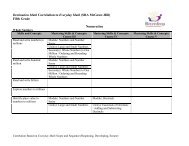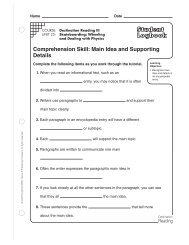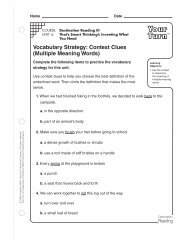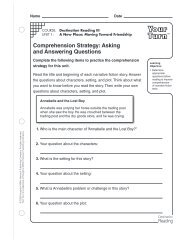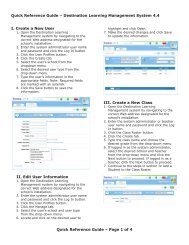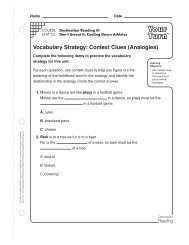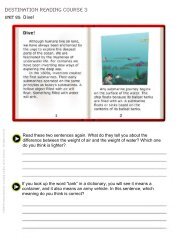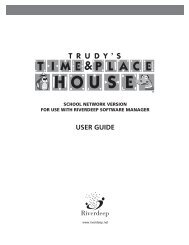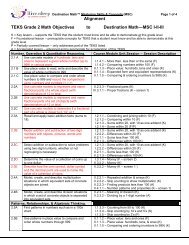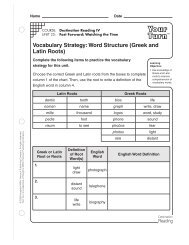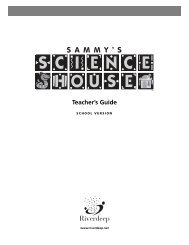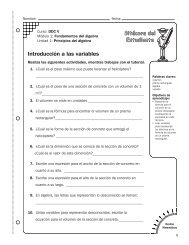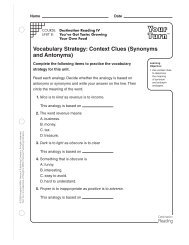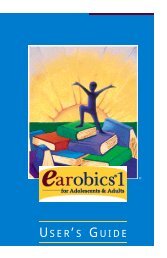Course III Teachers Guide.pdf - Houghton Mifflin Harcourt
Course III Teachers Guide.pdf - Houghton Mifflin Harcourt
Course III Teachers Guide.pdf - Houghton Mifflin Harcourt
You also want an ePaper? Increase the reach of your titles
YUMPU automatically turns print PDFs into web optimized ePapers that Google loves.
DESTINATION READINGGETTING STARTED 4ComprehensionThe end goal of all reading instruction is improved comprehension. As a result, informal and formal assessmentsfrequently are based on whether a student has understood what he or she has read. But comprehension instructionneeds to go beyond methods that merely check whether comprehension is taking place.Students’ abilities to understand what they read are strongly influenced by whatthey already know (or their background knowledge) about a topic. There is apositive correlation between background knowledge and comprehension. Manystudents, however, come to reading tasks, particularly academic reading tasks,with inadequate background knowledge. In many, but not all cases, theirbackground knowledge is inadequate because they have few little or noexposures to the content. Their comprehension may be improved by increasingboth the direct exposure they have to the subject matter of the text.Destination Reading <strong>Course</strong>s <strong>III</strong> and IV provide direct and indirect exposure tobackground knowledge relevant to the topic of each major text. Students mayview a slide show or a movie that exposes them to content they may notalready be familiar with, thus improving their chances of understanding what they are about to read.Comprehension strategies are tools that promote independent reading in students. Once learned, a comprehensionstrategy can be used and re-used when students encounter barriers to understanding and across diverse texts.Furthermore, adolescents can use comprehension strategies to extend their understanding of a text beyond its literalmeanings.Students who are exposed to a variety of comprehension strategies and who are given ample opportunities to practicethose strategies with increasingly challenging texts demonstrate improved comprehension. In addition, DestinationReading connects these strategies to life events. Learners might, for example, make inferences about a traffic jam ordraw conclusions about a missing piece of pizza. This connection facilitates transference—students’ ability to apply askill from their non-academic experience to the task of making meaning out of text.Destination Reading <strong>Course</strong>s <strong>III</strong> and IV include a carefully sequenced progression of 20 skills and strategies thatrepresent the research-based strategies. Students are guided by prompts in the interactive text to use comprehensionstrategies while reading. Following the reading, students have multiple opportunities to demonstrate understanding of thetext, at literal and more advanced levels. When students struggle to demonstrate comprehension, they are givenimmediate feedback to support them.Students also receive explicit instruction in comprehension strategies. They observe those strategies as they aremodeled and are given opportunities to practice them as they read. The interactive text prompts them, when appropriate,to make use of the strategy while they are reading. Students also have opportunities to apply what they’ve learned aboutthe text and reflect on the effectiveness of the strategy.The comprehension skills and strategies in Destination Reading are addressed several times through the program. Thecomplexity of the skill and the reading level of the passage in which that skill is applied increase through the program. Aswith vocabulary strategies, use the Manage tab in the Riverdeep Learning Management system to differentiateinstruction in your classroom.



